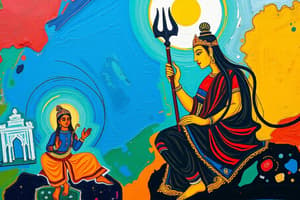Podcast
Questions and Answers
What is the central concept of Jainism?
What is the central concept of Jainism?
- Benevolence
- Compassion
- Ahimsa (correct)
- Asceticism
Who was the first Tirthankara of Jainism?
Who was the first Tirthankara of Jainism?
- Mahavira
- Buddha
- Rishabhadeva (correct)
- Arya
Which of the following is NOT one of the Four Principles of Jainism?
Which of the following is NOT one of the Four Principles of Jainism?
- Satya
- Dharma (correct)
- Asteya
- Ahimsa
What is the term for the experience of enlightenment in Jainism?
What is the term for the experience of enlightenment in Jainism?
Which order in Jainism is responsible for teaching or guiding others?
Which order in Jainism is responsible for teaching or guiding others?
How many Tirthankaras are there in Jainism?
How many Tirthankaras are there in Jainism?
Which value emphasizes non-attachment to material possessions in Jainism?
Which value emphasizes non-attachment to material possessions in Jainism?
What is the primary virtue that Jain monks practice to gain spiritual liberation?
What is the primary virtue that Jain monks practice to gain spiritual liberation?
Jainism is believed to have originated in the 6th century CE.
Jainism is believed to have originated in the 6th century CE.
The central concept of Jainism is ahimsa, which means non-violence.
The central concept of Jainism is ahimsa, which means non-violence.
The founders of Jainism are known as Muktakara.
The founders of Jainism are known as Muktakara.
Mahavira is considered the first Tirthankara of Jainism.
Mahavira is considered the first Tirthankara of Jainism.
Jainism initially had five orders of monks.
Jainism initially had five orders of monks.
The Four Principles of Jainism include Aparigraha, which encourages non-attachment.
The Four Principles of Jainism include Aparigraha, which encourages non-attachment.
Mahavira attained enlightenment under a tree near the river Ganges.
Mahavira attained enlightenment under a tree near the river Ganges.
The term kaivalya refers to the state of enlightenment in Jainism.
The term kaivalya refers to the state of enlightenment in Jainism.
Flashcards
Jainism Origins
Jainism Origins
Jainism began in India around the 6th century CE, alongside other prominent religions.
Ahimsa
Ahimsa
A central principle of Jainism, emphasizing non-violence towards all living beings.
Tirthankara
Tirthankara
A spiritual leader who has achieved enlightenment in Jainism.
Mahavira
Mahavira
Signup and view all the flashcards
Four Principles (Chatur-Ayam Dharma)
Four Principles (Chatur-Ayam Dharma)
Signup and view all the flashcards
Asteya
Asteya
Signup and view all the flashcards
Aparigraha
Aparigraha
Signup and view all the flashcards
Sadhu
Sadhu
Signup and view all the flashcards
What does 'Jain' mean?
What does 'Jain' mean?
Signup and view all the flashcards
What is the central belief of Jainism?
What is the central belief of Jainism?
Signup and view all the flashcards
Who are Tirthankaras?
Who are Tirthankaras?
Signup and view all the flashcards
Who is Mahavira?
Who is Mahavira?
Signup and view all the flashcards
What are Chatur-Ayam Dharma?
What are Chatur-Ayam Dharma?
Signup and view all the flashcards
What is Satya?
What is Satya?
Signup and view all the flashcards
What is Asteya?
What is Asteya?
Signup and view all the flashcards
What is Aparigraha?
What is Aparigraha?
Signup and view all the flashcards
Study Notes
Jainism
- Jainism originated in India in the 6th century CE. It emerged alongside other prominent religious traditions like Buddhism, Ajivika, Lingayatism, Kapalikas, Shaivism, and Vaishnavism.
- The word "Jain" comes from the Sanskrit word "Jina," meaning conqueror or victor.
- The central concept of Jainism is Ahimsa, non-violence.
- The founder of Jainism was Rishabhadeva, the first Tirthankara.
- Tirthankaras are revered teachers who show the path to liberation from the cycle of rebirth.
- Twenty-four Tirthankaras are recognized in Jainism.
- The 23rd Tirthankara was Parsvanatha, who is associated with Sammed Shikhar, a significant pilgrimage site.
- The 24th and last Tirthankara was Mahavira, believed to have achieved enlightenment under a Sal tree.
- Mahavira's teachings emphasized the importance of right knowledge, right faith, and right conduct to achieve liberation.
- Jainism emphasizes the concept of "Asteya" (non-theft), "Brahmacharya" (celibacy), and "Aparigraha"(non-possession).
Five Vows
- The core practices of Jainism are encapsulated in the five vows:
- Ahimsa (non-violence)
- Satya (truthfulness)
- Asteya (non-stealing)
- Brahmacharya (chastity)
- Aparigraha (non-attachment)
Jain Scriptures
- Jain scriptures are known as Agams.
Studying That Suits You
Use AI to generate personalized quizzes and flashcards to suit your learning preferences.




